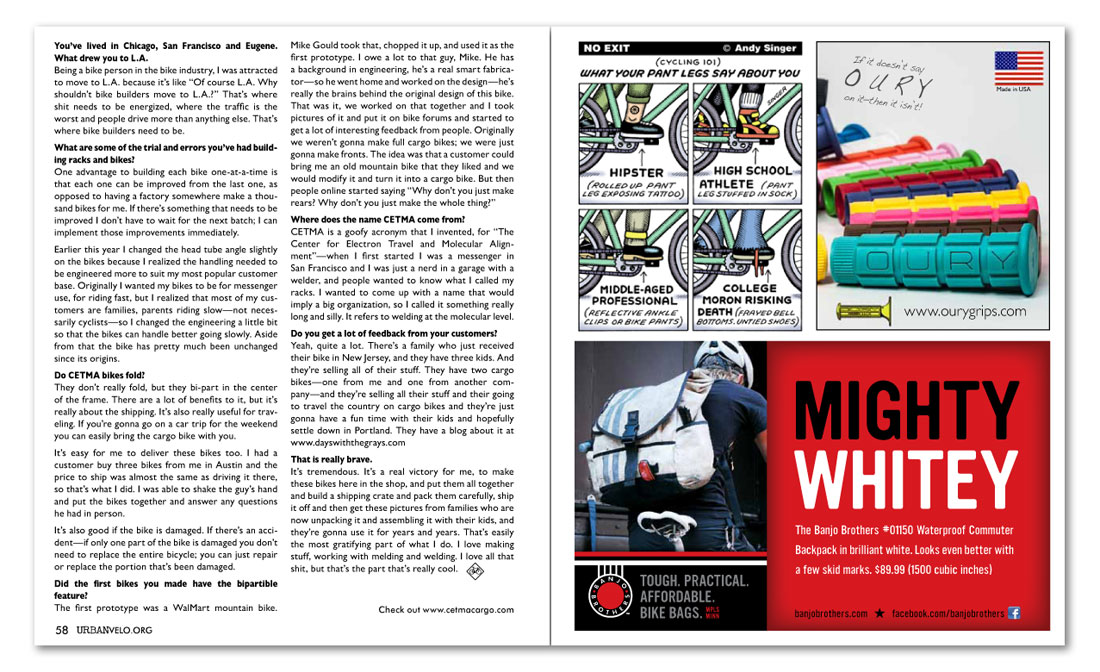


IYou’ve lived in Chicago, San Francisco and Eugene. What drew you to L.A.
Being a bike person in the bike industry, I was attracted to move to L.A. because it’s like “Of course L.A. Why shouldn’t bike builders move to L.A.?” That’s where shit needs to be energized, where the traffic is the worst and people drive more than anything else. That’s where bike builders need to be.
What are some of the trial and errors you’ve had building racks and bikes?
One advantage to building each bike one-at-a-time is that each one can be improved from the last one, as opposed to having a factory somewhere make a thousand bikes for me. If there’s something that needs to be improved I don’t have to wait for the next batch; I can implement those improvements immediately.
Earlier this year I changed the head tube angle slightly on the bikes because I realized the handling needed to be engineered more to suit my most popular customer base. Originally I wanted my bikes to be for messenger use, for riding fast, but I realized that most of my customers are families, parents riding slow—not necessarily cyclists—so I changed the engineering a little bit so that the bikes can handle better going slowly. Aside from that the bike has pretty much been unchanged since its origins.
Do CETMA bikes fold?
They don’t really fold, but they bi-part in the center of the frame. There are a lot of benefits to it, but it’s really about the shipping. It’s also really useful for traveling. If you’re gonna go on a car trip for the weekend you can easily bring the cargo bike with you.
It’s easy for me to deliver these bikes too. I had a customer buy three bikes from me in Austin and the price to ship was almost the same as driving it there, so that’s what I did. I was able to shake the guy’s hand and put the bikes together and answer any questions he had in person.
It’s also good if the bike is damaged. If there’s an accident—if only one part of the bike is damaged you don’t need to replace the entire bicycle; you can just repair or replace the portion that’s been damaged.
Did the first bikes you made have the bipartible
feature?
The first prototype was a WalMart mountain bike. Mike Gould took that, chopped it up, and used it as the first prototype. I owe a lot to that guy, Mike. He has a background in engineering, he’s a real smart fabricator—so he went home and worked on the design—he’s really the brains behind the original design of this bike. That was it, we worked on that together and I took pictures of it and put it on bike forums and started to get a lot of interesting feedback from people. Originally we weren’t gonna make full cargo bikes; we were just gonna make fronts. The idea was that a customer could bring me an old mountain bike that they liked and we would modify it and turn it into a cargo bike. But then people online started saying “Why don’t you just make rears? Why don’t you just make the whole thing?”
Where does the name CETMA come from?
CETMA is a goofy acronym that I invented, for “The Center for Electron Travel and Molecular Alignment”—when I first started I was a messenger in San Francisco and I was just a nerd in a garage with a welder, and people wanted to know what I called my racks. I wanted to come up with a name that would imply a big organization, so I called it something really long and silly. It refers to welding at the molecular level.
Do you get a lot of feedback from your customers?
Yeah, quite a lot. There’s a family who just received their bike in New Jersey, and they have three kids. And they’re selling all of their stuff. They have two cargo bikes—one from me and one from another company—and they’re selling all their stuff and their going to travel the country on cargo bikes and they’re just gonna have a fun time with their kids and hopefully settle down in Portland. They have a blog about it at www.dayswiththegrays.com
That is really brave.
It’s tremendous. It’s a real victory for me, to make these bikes here in the shop, and put them all together and build a shipping crate and pack them carefully, ship it off and then get these pictures from families who are now unpacking it and assembling it with their kids, and they’re gonna use it for years and years. That’s easily the most gratifying part of what I do. I love making stuff, working with melding and welding. I love all that shit, but that’s the part that’s really cool.